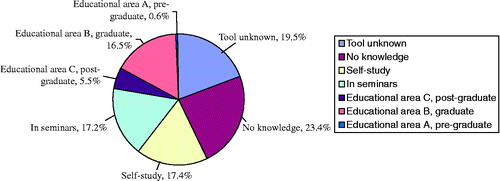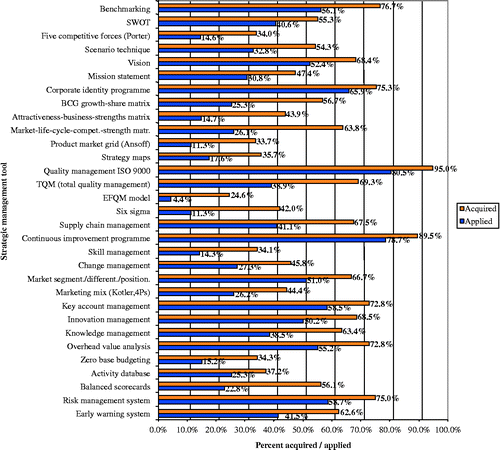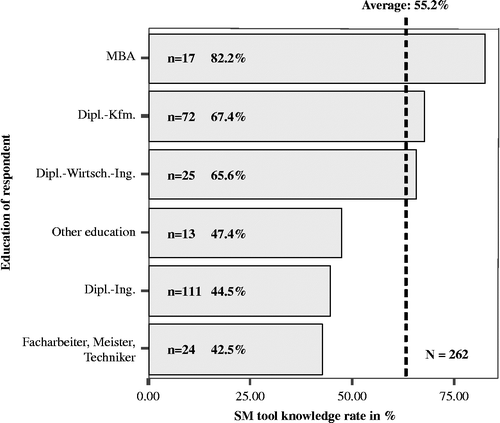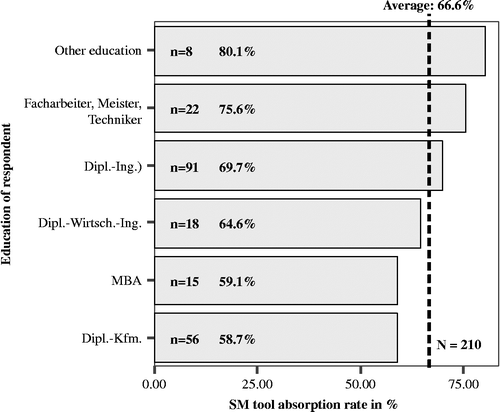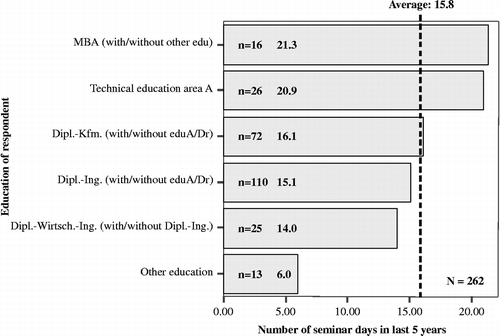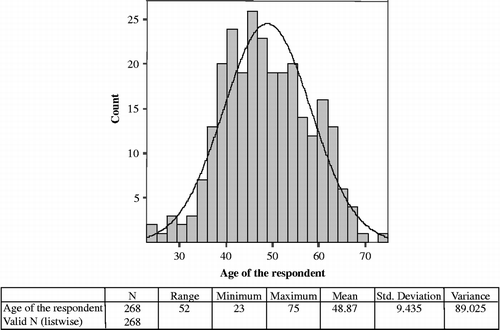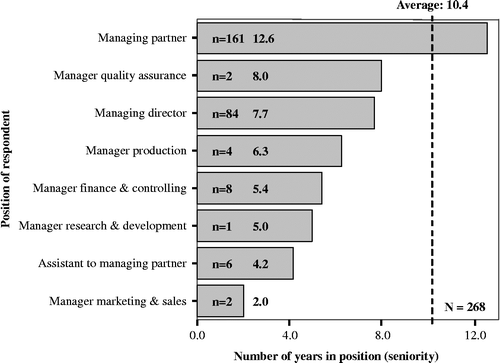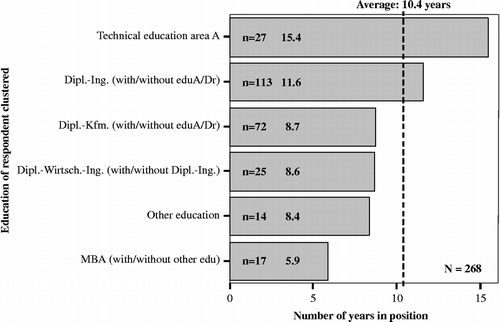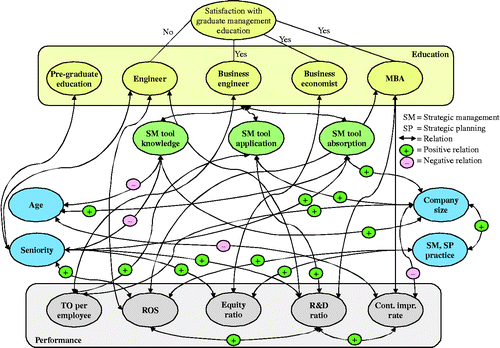Abstract
This paper examines the strategic tool kit, from a human resource management (HRM) perspective, in terms of usage and impact. Research to date has tended to consider usage, assuming to a certain extent that knowledge and understanding of particular tools suggest that practitioners value them. The research on which this paper is based builds upon the idea that usage indicates satisfaction, but develops the usage theme to investigate which decision-makers are actually engaged in both tool appliance and the strategic process. Of particular interest to the researchers are the educational background, age and seniority of the decision-makers. In addition, potential links with HRM and organizational performance are also explored. The context of the research, the German machinery and equipment sector, provides an insight into the industry's ability to sustain growth in face of increasing international competition. The paper calls for a greater awareness, from a human resource perspective, and utilization of strategic management practice and associated decision-making aids.
Introduction
Senior practitioners, the key strategic decision-makers, have been encouraged, for many years, to utilize and deploy some form of strategic toolkit. Such toolkits should assist the user in better understanding the operational and business environment and enhance decision-making. In short, toolkits aid decision-making and ultimately enhance performance.
The toolkit package, consisting of an array of business/management analytics, frameworks, models and at times philosophies, intended to enhance understanding and knowledge of both the internal and external business environment, has varied over time, reflecting prevailing fashions and both personal and organizational preferences. There are numerous toolkit advocates; business schools, academics, consultants and management gurus all have their favourites. With so many vested interests and toolkit variants, many with caveats regarding usage and relevance, how often has the true value of the toolkits been questioned? For example, how and to what extent do the key decision-makers actually engage in the strategic process, do they use a toolkit, if they do, how did they acquire the knowledge and understanding and to what extent do such tools impact on decision-making capability and performance? Finally, do the human resource (HR) profiles of senior management, age, seniority and education influence usage or adoption of strategic decision-making aids?
It is only relatively recently that researchers have turned their attention to the questions and issues raised above; many scholars and practitioners have expressed concerns about particular models or approaches, questioning their ability to address complex and dynamic situations. Others have focused, mainly from a human resource management (HRM) perspective, on the capability of the users, questioning user decision-making skills, with the much-maligned MBA taking the brunt of the criticism. Few studies actually address strategy toolkit impact, in particular HR aspects relating to user profiles and usage patterns have been generally ignored. All too often there appears to be an assumption that in our hyper connected and educated world that the strategic decision-maker(s) will be armed with a raft of management knowledge and aware of the importance of HRM, engaged with ongoing personal development and a fully paid-up member of the strategy fan club. However, as this paper illustrates, this is not always the case.
The paper is structured as follows. A literature review provides an overview of toolkit usage, patterns and performance. This is followed by the research context, the state of management education in Germany and a brief literature review pertaining to age, seniority and performance. Figure details the particular tools that are investigated; at least six tools relate in general terms to the HR functional area, thus the desire to investigate the HR dimension of strategy formulation and performance. Next, an explanation of how the study identified a suitable strategic toolkit for the empirical research is provided. The paper then considers the research methodology and the findings. Finally, the paper closes with the study's conclusions. The capacity of certain findings, particularly those associated with professional education, to be generalized beyond the shores of Germany may be limited. However, toolkit appliance, usage and performance impact findings, can, in the authors' view, be generalized more widely, in particular how do HR-related issues, such as educational background, age and seniority impact on organizational performance.
Strategic tool case usage patterns and performance
The strategy literature took some time, given the subject can trace its origins back to the 1950s, to address through empirical research the adoption, appliance and effectiveness of associated toolkit packages. By the early 1990s, researchers had started to show an interest in the subject. Clark (Citation1992) conducted a literature analysis that examined the application of management tools in strategic planning and defined a set of 24 management science tools. Having canvassed, on an international basis, almost 500 companies, Graves (Citation1994) identified 25 most commonly used management tools, which in turn could be associated with the following activities and initiatives: mission building, customer surveys, total quality management, benchmarking and reengineering. Unfortunately, no linkages could be found between a tool's popularity and financial performance. Withrow (Citation1995) repeated the Graves study, focusing on performance; Withrow found that decision-makers who were particularly concerned with financial performance tended to have highly ranked activity-based costing. An international study by Gillies (Citation1995) found that companies tended to have favourite tools and did not deliberately seek out new decision-making aids. Clark and Scott (Citation1999) investigated the usage of 25 management science/operational research tools in the UK and New Zealand. Significant involvement of management science and operational research were discovered along the scope of strategic tasks. Tools such as spreadsheet modelling, forecasting, cost benefit models and project management score highest in both countries.
The turn of the millennium witnessed a growth of research interest. Dyson (Citation2000) explores the nature of operational research and its interaction with performance measurement and strategy using a management toolkit. He states that problem-structuring methods are an important aid in formulating strategies and policies and that operational research plays a role in performance measurement. In a study based in the USA, the most popular tools identified were strategic planning aids, mission and vision initiatives and benchmarking (Rigby Citation2001a,Citationb). In addition, the majority of respondents agreed that tools tended to promise, in terms of performance, more than they delivered. Once again in the USA, N. Nohria's (2003, cited in Jacobs Citation2003) study of 160 corporations, over a 10-year period, could not find a correlation between popular management practices and profitability. In 2005, a worldwide survey of almost a 1000 enterprises identified that tools or approaches associated with customer acquisition and retention, as well operational and services outsourcing, were the most popular amongst senior decision-makers. Chen and Jones (Citation2007) found tools associated with planning, benchmarking and continuous improvement to be most popular amongst a group of 100 MBA students. Gunn and Williams (Citation2007) argue that companies should employ a range of strategic tools and avoid, if possible, limiting their choice of approaches. Stenfors, Tanner, Syrjänen, Seppälä and Haapalinna (Citation2007) investigated the role of operational research and management tools in the decision-making process of Finland's largest 500 companies. They noted that executives claimed that tool usage was advantageous and called for additional tool to enhance creativity. In a UK study into the applicability and effectiveness of two tools, value chain management and stakeholder analysis, across seven public consulting projects, Williams and Lewis (Citation2008) suggest both tools enhanced the strategic process and outcomes.
Jarzabkowski, Giulietti and Oliveira (Citation2009) constructed a listing, by consulting academics from leading UK business schools, of the most popular strategic tools and approaches; they narrowed the list down to 20. They then turned to practitioners; 2000 alumni drawn from mainly the top 10 UK business schools were contacted. The top ranked tools were SWOT analysis, key success factors, core competence analysis (all of which can be linked to HRM strategy and practice) and scenario planning, with respondents claiming regular use of up to five tools. In a case study, Moisander and Stenfors (Citation2009) researched the theory–practice gap in strategic management. They argue that some management scholars produce knowledge and tools that lack practical relevance; they call for tools that support collective knowledge production, dialogue, trust and learning. Wagner (Citation2011) surveyed approximately 700 European manufacturers, mainly in Germany. He was interested in identifying what types of tools impacted most positively on profitability, there was some suggestion that the balanced score card in combination with tight financial control provided the best results. Rigby and Bilodeau (Citation2011) and Rigby (Citation2011) suggest that toolkit usage varies over time and from country to county. O'Brien (Citation2011) reports on an online survey conducted with operational research practitioners. The research revealed that practitioners actively support the strategy process whilst they also report using a wide variety of operational research/management tools.
The majority of researchers have concentrated on identifying the most popular tools, a few have then tried to link usage with performance, but none have endeavoured to establish the sources of the underpinning knowledge and understanding, nor the profile of the decision-maker.
This paper seeks to complement the research noted above by specifically addressing the linkages between usage, performance and executive profiles. The German machinery and equipment sector provides the research context; the research aim being to establish the extent to which decision-makers are familiar with and use the tools and techniques associated with strategic management. Of particular interest were issues and HR practices associated with knowledge acquisition, decision-maker profiles and organizational performance. Please note that the research did not seek to identify causal relationships; there are too many factors and variables at play, the aim was to identify and investigate indicative relationships. The agenda was one of engagement with practice; the sector under study is in the vanguard of the German economy's recovery from the 2008/2009 recession (BMWT Citation2010; Spiegel Citation2010). However, as shown later, the key decision-makers within this industrial sector, together with those in associated professional bodies, including higher education (HE), appear relatively uneasy with management theory and fail to grasp the HR dimension.
The German machinery and equipment sector
Less than a decade ago, the machinery and equipment sector turnover was €132.6 billion and it consisted of over 6000 enterprises, this in turn equated to almost 9% of manufacturing revenues and 2% of all enterprises (VDMA Citation2005). According to IDW (Citation2005), the sector accounted for 1 million jobs and contributed in investment €4.3 billion to the economy, over 70% of output was exported and it was the largest exporting industry. The machinery and equipment sector is faced with mounting strategic challenges, particularly from India and the Far East (Ihrcke Citation2007; Baron Citation2005; Sieren Citation2006; Impuls Citation2007; VDMA Citation2007a). The sector continues to drive the economy forward, especially with regard to exports (BMWT Citation2010). In 2010, the sector's turnover was €173.4 billion (VDMA Citation2011), illustrating an increasing trend, despite the worldwide economic crisis of 2008/2009; its continued well-being is vital for Germany. One would assume that such a successful industry would take the maintenance of strategic capability, including HR policy and practice, seriously and be in tune with a dynamic business environment, thus the researchers' interest in it and selection of it for this particular study.
The sector is predominantly made up of small- and medium-sized enterprises (SMEs). It is worth noting that in Germany, an SME is defined differently than the standard EU definition. The German IfM (Institut fuer Mittelstandsforschung [Institute for SME Research]) defines enterprises as follows: small enterprises have up to 9 staff and turnovers of less than €1 million; medium-sized enterprises employ 10–499 with a turnover of up to €50 million (Guenterberg and Kayser Citation2004). IfM calculates that this accounts for approximately 3.5 million enterprises that in turn create over 80% of all apprenticeships and account for 70% of all jobs (Guenterberg and Kayser Citation2004). Statistics such as these reinforce the importance of SMEs to Germany's socio-economic well-being.
The state of management education
As an SME-centric industry, the machinery and equipment sector is clearly important, so who makes the decisions? Staufenbiel (Citation2007) notes that engineers hold the majority of senior management positions and the VDMA (Citation2007b) also state that the key decision-makers are predominantly engineers. Unfortunately, management education does not feature to any great extent within the German engineering curriculum (Bundesagentur fuer Arbeit Citation2007) resulting in a senior management cadre, in a prime economic sector, potentially lacking strategic HRM awareness and skills. Feller and Stahl's (Citation2005) future of engineering study called for basic business economics, but not for managerial education, indeed they strongly suggested that there should be no further dilution of the engineering qualification. Sattelberger (Citation2007) suggests the engineering curriculum should engage with practice, but there is no mention of management education. This could explain why the study by Dembkowski (Citation2007) points to a lack of strategic management competence amongst senior German executives.
A key industry appears to be led by decision-makers who are not conversant with contemporary management concepts and approaches. This is particularly worrying as studies suggest managerial, in particular strategic management, education can be linked to organizational performance. Cockerill (Citation1993), Lee, Coaley and Beard (Citation1993), Winterton and Winterton (Citation1996), Barling, Weber and Kelloway (Citation1996), Thompson (Citation2000), Horne and Stedman Jones (Citation2001), Longenecker and Ariss (Citation2002), Mabey and Ramirez (Citation2003) and Held, Ruppert and Ziegenbein (Citation2007) all suggest an association between management education and organizational performance.
By exploring the nature and state of senior management education in terms of both the knowledge and application of strategic toolkits, whilst exploring potential performance linkages, the research, whilst contributing to the literature appertaining to strategic toolkits, will also provide a basis for advising policymakers and professional bodies with regard to decision-maker profiles and certain HR competencies. The profiling, from an HR perspective, will focus on educational background, age and company seniority.
Age, seniority and performance
Research regarding age or seniority and performance is limited; some studies have found that within the machinery and equipment sector, ownership and management often rest with the family concerns (Hechtfischer Citation2004; Schluechtermann and Pointner Citation2004; Roehl Citation2005). In such enterprises, the senior decision-makers are ageing, having had long periods in control, without fully addressing succession planning (Ballarini and Keese Citation2002; Hofmann Citation2004; Kayser Citation2004).
Waldman and Avolio (Citation1986, p. 36) conducted a meta-analysis for non-professionals and professionals and discovered that ‘the widespread belief that job performance declines with age was not strongly supported’. Some evidence pointed to the increase of performance with age. Differences were traced to varying performance measures. McEvoy and Cascio (Citation1989) reviewed research results from various studies and concluded that age and job performance are generally unrelated. Ng and Feldman (Citation2008, p. 392) in further research investigating the existence or non-existence of a relationship between age and ‘ten dimensions of job performance’ produced inconclusive results. It may be worth noting that ‘seniority’ and ‘age’ are not one in the same thing; Webster (Citation1983, p. 1651) defined ‘seniority’ as ‘the number of years served in the current position’.
Strategic toolkit used for the empirical research
Management scientists and consultants have developed and introduced numerous strategic approaches, protocols and tools. Tools have been designed to impact on organizational and functional aspects of any organization. Managers use toolkits to ‘resolve uncertainties, understand the market and technology, map out the existing project portfolio, and ultimately inform strategic choices about investment’ (Jarzabkowski and Kaplan Citation2008, p. 1).
The proliferation of tools and approaches has attracted interest from scholars wishing to establish if they actually work, how best to deploy them and to what extent can they be integrated (e.g. Kappeller and Mittenhuber Citation2003; Wagner Citation2007; Jarzabkowski et al. Citation2009; Rigby and Bilodeau Citation2011). Readers may find Kappeller and Mittenhuber (Citation2003) of interest, they produced an alphabetic listing of over 300 management techniques in their publication ‘Management Konzepte von A bis Z’ (Management Concepts from A to Z).
The first challenge with regard to the empirical research was to select, from the numerous approaches, protocols and tools, which strategic management-related techniques/activities to test for practitioner knowledge and application. It was decided to take an E2E view of the strategic management process (McCarthy, Minichiello and Curran Citation1975; Wagner Citation2001; Welge and Al-Laham Citation2003) and assign the associated tools to each stage in the process. Initially, almost 90 tools were allocated; then by looking to the literature for commonality and strategic relevance, the questionnaire design for time scales (Saunders, Lewis and Thornhill Citation2003) and the actual spread of tools (no less than two and no more than 5 per phase or functional area), this was narrowed down to 31. The strategic process phases are detailed in Figure : strategic analysis; strategic premises and settings; formulation of paramount strategies (strategic direction); functional business strategies (including three directly relating to HR and a further three, innovation, knowledge and quality linked to HR); strategy execution and controlling. The figure also indicates the allocation of tools to each phase.
Methodology
The Hoppenstedt database (Hoppenstedt Citation2005, Citation2006) was used to identify respondents as it provided, in 2007, the most comprehensive and current industry listing. For example, it detailed NACE classifications, addresses (mail, fax/phone, e-mail/Internet), year founded, staffing, turnover, return on sales, investment and equity ratios. It also provided executive names, titles and functions. As previously noted, the largest component of the sector in question consists of SMEs; Hoppenstedt facilitated the identification of potential respondents with 10–500 staff who fell within the NACE codes 29.6 through 29.72 (Eurostat Citation2006). The research excluded armaments and appliance manufacturers.
Data on positions, education, age and seniority, strategic knowledge, tool application and performance were collected by a self-administered questionnaire. A professionally produced and comprehensive industry listing identified respondents, leading the researchers to be confident that they were reaching the key decision makers. The listing provided audited performance data with which one could at least seek to identify performance relationships with particular executive profiles or tool usage. The authors adopted a positivistic stance throughout.
A low response rate was expected (Friedrich Citation2008) and a 50-SME pilot study provided confirmation. It was decided to contact all 6000 enterprises that fell within the sector and met the SME specifications, by postal and web-based questionnaires. By January 2009, 290 responses had been received (a postal rate of 6.9% and web of 3.0%). No significant return bias was identified (SPSS compare means modelling and ANOVA) and non-response bias (Filion Citation1975; Colombo Citation2000; Socha Citation2006) was negligible, assessed by the comparison of response with known population values (Armstrong and Overton Citation1977).
Data analysis and evaluation was conducted using SPSS (v.15) and the package (SPSS Citation2006a,Citationb) also dealt with the descriptive statistics (Elsner Citation2003; SPSS Citation2006a,Citationb; Diehl and Staufenbiel Citation2007). Variable relationship analysis was managed by the following inference statistics (Fisher Citation1959; Pryce Citation2005; Moutinho and Hutcheson Citation2006, Citation2008; SPSS Citation2006a,Citationb; Diehl and Staufenbiel Citation2007; Kinnear and Gray Citation2008):
ANOVA table and significance level for hypothesis testing;
Comparison of means to evaluate the relation of continuous variables with categorical variables (ordinal, dichotomous, nominal);
Cross-tabulation, Pearson chi-square test to evaluate the relation between categorical variables (ordinal, dichotomous, nominal);
Linear regression for exploring relations between continuous variables;
Scatter plots to display and calculate the relation of continuous variables.
A deeper understanding of the respondent's knowledge and attitude towards the subject at hand was assisted by an examination of open-ended questions. The research methodology described above, namely a quantitative approach with qualitative follow-up, was considered as the most effective way to address the research aims and contribute to existing knowledge and understanding.
Findings and discussion
The research findings are presented with the aid of tables, bar charts and graphics. They commence with a brief general overview and move on to deal with aspects relating to strategic toolkit knowledge and application, followed by educational issues, for example, acquisition, application and absorption rates. The section concludes with the findings regarding age and seniority in relation to HR policy and practice, toolkit knowledge, practice and performance. The following sections shed some light on the questions posed within the introduction, to recap, how and to what extent do the key decision makers actually engage in the strategic process, do they use a toolkit, if they do, how did they acquire the knowledge and understanding and most importantly to what extent do such tools actually impact on decision-making capability and performance? Finally, do the HR profiles of senior management, age, seniority and educational background influence usage or adoption of strategic decision-making aids?
In General
Approximately 60% of respondents were managing partners/owners and the majority of the remainder, over 30%, managing directors. The survey reached the key decision makers with 92% of respondents being senior executives and the remaining 8% second-tier executives. Men dominated the executive positions (93.3%), with 42% possessing an engineering degree as their highest qualification, with a further 10% a vocational engineering qualification. Engineers, when one adds those holding a joint qualification in engineering and business, accounted for 60% of the executive positions. The next most popular higher qualification was that of business economist (27.1%), with the MBA accounting for only 6.3%. These results bear out the findings of previous studies (VDMA Citation2007b); the sector is indeed run by engineers.
Knowledge sources
Educational sources of strategic toolkit knowledge are depicted in Figure . The chart summarizes sources as follows: area A pre-graduate, 0.6%; area B graduate and area C postgraduate, respectively, 16.5% and 5.5%; seminars accounted for 17.2%; and self-study 17.4%. However, knowledge of 20% of the tools is lacking and 23% are not known at all. Once again, such findings echo those of previous studies (Ramirez Citation2004) in that HE does not appear to be the source of management knowledge.
Acquiring and applying the strategic toolset
The management tools acquired and applied are depicted in Table and Figure . The average knowledge rate is at 57%, and less than 20% of this knowledge was acquired during graduate education. The vast majority of the companies are ISO 9001 certified and this accounts for quality-related tools and approaches ranking highly. Other popular tools are associated with continuous improvement and risk management; however, tools such as EFQM, Ansoff grid or six-sigma are rarely applied. Strategy-related marketing and HR (with the exception of the human dimension of quality and operationally related continuous improvement initiatives) tools, given the competitiveness of the sector, score surprisingly low. Overall the average application rate is 36.6%. This rate appears low and can be attributed to a general lack of management knowledge; such a result tends to confirm Dembkowski's (Citation2007) assertion that German executives possess little strategic knowledge or capability.
Table 1 Knowledge and application of strategic management tools.
Education and knowledge acquisition
Figure suggests respondents have acquired knowledge of approximately half the tools (average rate 55.2%); given that they represent the most senior decision makers, this rate seems low. MBAs holding senior positions have acquired the highest rate (82%), followed by business economists/engineers (67% and 65%). Engineers show the lowest rates (44.5% and 42.5%). SPSS ‘compare means’ modelling and ANOVA showed that differences between the groups are statistically significant (Sig. 0.000).
Education and toolkit application
Figure depicts toolkit application rate by education. Respondents were included only when they were directly responsible for strategic management and/or their company applied the principles of strategy (210 cases). Once again the average appears low (36.6%), with MBAs, business engineers/economists (47.1%, 41% and 40.7%, respectively) above average and those with engineering backgrounds well below (32.7% and 30.8%). This again suggests a lack of knowledge and application of key decision-enhancing tools and concepts. SPSS ‘compare means’ modelling and the ANOVA table showed that differences between the groups are statistically significant (Sig. 0.015).
Education and toolkit absorption
As mentioned above, only the 210 actively engaged respondents are considered. Figure shows the average strategic management tool absorption rate (applied tools/acquired tools) by educational background. Those with a technical education achieve the highest level (75.6%), with engineers sitting at 69.7% and at the lower end of the scale can be found the MBAs and business economists. The technocrats and engineers seem to be more inclined to apply acquired knowledge in praxis. SPSS ‘compare means’ modelling and the ANOVA table showed that differences between the groups are statistically significant (Sig. 0.022).
Education and continuing education
Respondents claimed (85% over the past five years), as depicted in Figure , to engage in some form of continuing professional development associated with management and toolkits, further they averaged three days training per year. MBAs and non-graduates led the way with the remainder a few percentage points behind. With the aid of the SPSS and ANOVA, there is no significant statistical difference between the means of the groups (Sig. 0.196).
Age and seniority
As depicted in Figure , respondent age ranges from 23 to 75 years, the average being 49. Ten executives have passed the retirement age, eight of them are managing partners, two are managing directors and, of that number, seven are engineers.
Executives have on average just over 10 years' service in their current position. Seniority ranges from 1 to 37 years. Managing partners have been in their present position for almost 13 years. Figure provides the detail. SPSS ‘compare means’ modelling and the ANOVA table show the relationship between number of years in position and the actual present position of the respondent to be statistically significant (Sig. 0.000). Thus, the average seniority is related to and dependent upon position of the respondent.
As shown in Figure , executives with a technical education tend to stay longest in their position (15.4 years) and engineers follow with 11.6 years. MBAs have the lowest seniority rating with an average stay of about six years. The differences between the groups are statistically significant (Sig. 0.000). Thus, the seniority is related to and dependent on the type of education.
Age and toolkit knowledge and practice
The respondent's age, as shown in Table , relationship with variables associated with knowledge and praxis were evaluated with the aid of linear regression and the ANOVA test. The relationship between age and the dependent variables is significant. Scatter plots revealed that toolkit knowledge declines and tool absorption rate increases with age. Older executives appear to have failed to keep up to date, but are more inclined to put what knowledge they have into practice.
Table 2 ANOVA, relation of age with various variables (toolset).
Seniority and toolkit knowledge and practice
Table illustrates the seniority relationship with knowledge and praxis variables (evaluated with the aid of linear regression and ANOVA testing). Variables with a significance level of Sig. ≤ 0.050 were further analysed by a scatter plot. Seniorities relationship with these dependent variables is significant. Scatter plots revealed that the toolkit knowledge declines and the tool absorption rate increases with the age of the respondent. The findings correlate with age. Executives once again appear to acquire less toolkit knowledge with seniority, but what they do know they appreciate far more.
Table 3 ANOVA, relation of seniority with various variables (toolset).
Relation of age with performance outcome
Table explores the relationship between respondent age and company performance variables with the aid of linear regression and the ANOVA test. Variables with a significance level of Sig. ≤ 0.050 were further analysed with a scatter plot. Older executives seem to be less inclined to employ continuous improvement tools.
Table 4 ANOVA, relation of age with key performance indicators.
Relation of seniority with performance outcome
Depicted in Table is the relationship between respondent seniority with variables associated with performance, evaluated with the aid of linear regression and the ANOVA test. Variables with a significance level of Sig. ≤ 0.050 were further analysed by a scatter plot. For return on sales, equity and R&D ratio the relationship between seniority with the dependent variables is significant. The findings suggest that executives who have been longer in their current position generate a higher return on sales, provide a higher equity ratio and invest more in R&D. Seniority may assist in facilitating sustainable futures.
Table 5 ANOVA, relation of seniority with key performance indicators.
Conclusions
The intention of this paper and associated research, as noted in the Introduction section, was to address the following questions: how and to what extent do the key decision makers actually engage in the strategic process, do they use a toolkit, if they do, how did they acquire the knowledge and understanding and to what extent do such tools impact on decision-making capability and performance? Finally, do the HR profiles of senior management, age, seniority and education influence usage or adoption of strategic decision-making aids? The associated research has provided an insight into the current status of strategic toolkit knowledge and application in relation to HR factors such as age, seniority and performance, within the German machinery and equipment sector. In so doing the hope is not only to establish the facts relating to current decision-making but also to shape future policy and practice. The importance of the sector to the German economy has been noted, as was the growing competition from developing economies, which are logistically better placed to serve emerging markets and are enhancing their product/service offering (Bitzer et al. Citation2004; Koehler et al. Citation2006; Steingart Citation2006; Impuls Citation2007). The authors contend that if this pivotal industry is to continue to lead the German economy, then the decisions it takes regarding future strategic investment, in particular decisions relating to how it deploys and manages its HR, will be critical; executives must be well informed and capable of managing strategic change. In particular we would draw attention to the following.
Knowledge of management tools and their application
Ramirez (Citation2004, p. 441) stated that ‘German managers appear to develop their managerial skills almost wholly in-house’. Nothing appears to have changed; this study identified a relatively low management tool knowledge rate of 57.1% and noted that this was acquired mainly postgraduation (16.5% acquired during formal studies). The senior executive respondents admitted to only applying 36.6% of the listed tools. This supports Dembkowski's (Citation2007) assertions, namely the main weakness of German managers lies in their lack of strategic thinking and experience.
Education and toolkit knowledge, application and absorption
The relationship between of the type of graduate education and tool knowledge is significant. MBAs acquired twice as much knowledge (82.2%) as engineers (44.5%). The lack of management knowledge amongst German managers is surprising given the importance, previously reported, that many practitioners, professional bodies and academics place upon the integration of engineering and management education. The relationship between graduate education and the application rate of tools is significant. Respondents with technical backgrounds (Facharbeiter, Meister and Techniker) and professional engineers exhibit the lowest rates (30.8% and 32.7%). On the other hand, there is evidence that engineers are more inclined to apply management knowledge when acquired (toolkit absorption rate of 69.7%).
Age and seniority
Some executives are 10 years beyond normal retirement. This has been identified as a problem by researchers as it may lead to very late handovers to the next generation, in short poor succession planning (Boes and Kayser Citation1996; Gruhler Citation1998; Ballarini and Keese Citation2002; Kayser Citation2004). Compared to others, engineers remain longer as executives. Executives owning the company stay longest. Employed managing directors tend to move on more frequently. There is strong evidence that compared to other professions executives with a technical education and engineers stay the longest.
Age and seniority knowledge and practice
The findings suggest that older executives and those with high seniority had little or no management education and/or have failed to keep their management knowledge up to date. On the other hand, they are more inclined to apply management knowledge once acquired. However, there is no evidence that older executives and those with high seniority spend less time on continuing management education.
Age and seniority and performance
There appears to be little relationship between age and key performance indicators, with exception of those associated with continuous improvement, the rate of which is significantly lower for enterprises run by older executives. This suggests they are less familiar with continuous improvement tools such as Kaizen (Imai Citation1992). However, the findings suggest that seniority seems to have a greater impact on success. Executives with higher seniority may have a significantly lower tool knowledge and application rate, but they generate greater profit and a favourable balance sheet. They are also significantly more involved in R&D, which acts positively on ROS (Figure ). One of potentially many issues that emerges from these findings relates to the advocacy, or not, of encouraging senior decision-makers to move on, and this study suggests that continuity and seniority both lead to enhanced performance; such a finding has significant HR implications.
Findings and conclusion overview
Figure depicts an overall summary of the key findings and conclusions of the research; it illustrates the nature and strength of the relationships between the key variables. Relationships with statistical significance are denoted by a positive (+) or negative ( − ) sign, e.g. high seniority to high ROS or R&D ratio or high age to low knowledge of strategic tools.
The research context places some constraints on the degree to which one could generalize certain aspects of the findings and conclusions. Dealing with the most problematic aspect, namely the relatively unique nature of German post-school and higher education, educational providers catering for engineering professionals, along with the associated funding bodies and professional institutes, must be made aware of the dangers of neglecting management education; only 16.5% of the professionals acquired any management knowledge from graduate studies. It would be wise for educationalists, policymakers and the engineering professionals to benchmark against their international contemporaries, learn from best practice and upskill/modernize their approach (Paton, Wagner and MacIntosh Citation2012).
Moving on to a slightly less contentious issue with regard to the degree to which the findings could be more generally applied, professional engineers, across the globe, can find themselves at the helm of an enterprise. The findings suggest a degree of association between the appliance of management capabilities, the toolkit and enhanced organizational performance. Furthermore, the appliance of the components relating to HR, such as change management, experience and potentially longevity of service also benefits the organization.
As for the impact on decision-makers in general, age and seniority bring both dividends and challenges. Pertinent knowledge and understanding stands the test of time. Performance appears linked in some way to seniority, but not apparently to age, but yet age seems negatively associated with continuous organizational improvement. Possibly, age brings a desire for the status quo, whilst seniority encourages drive and engagement. In addition, acquired knowledge sticks, so one might suggest acquire as much strategic expertise on the ‘way up’, preferably within graduate or equivalent education. Finally, the findings suggest that continuity of service may be beneficial. Decision-makers who stay the distance tend to be associated with the better performing enterprises. Such findings may impact on HR debates and practices associated with succession planning, experiential learning and possibly job rotation and non-executive input. With regard to job rotation and non-executive inputs, research relating to the former has tended to concentrate on what might be termed the ‘shop floor’ (Hsieh and Chao Citation2004; Eriksson and Ortega Citation2006; Jaturanonda, Nanthavanij and Chongphaisal Citation2006), but there may be positive scope for considering rotation at a more senior level.
It would appear that one should challenge the future and apply what knowledge one has acquired, whilst being aware that there appears to be a point when seniority gives way to age! Obviously, such recommendations are not necessarily, due to the many factors and variables at play, as clear-cut as stated here. The authors would call for additional research, of a more qualitative nature, to delve deeper into the underpinning causes and linkages. In addition, it may also be wise to give serious consideration to the creation of a directorate licence. In the face of growing concerns relating to the competency and efficacy of our industrial leaders (Podolny Citation2009), is it not time to licence directors, board members and executive directors?
Acronyms and glossary
| ANOVA | = | Analysis of variance |
| BCG | = | Boston Consulting Group |
| BMWT | = | Bundesministerium fuer Wirtschaft und Technologie (Ministry of Economy and Technology) |
| Dipl.-Ing. | = | Diplomingenieur (diploma engineer), academic degree for German engineers |
| Dipl.-Kfm. | = | Diplomkaufmann (business economist) |
| Dipl.-Wirtsch.-Ing. | = | Diplomwirtschaftsingenieur (business engineer) |
| E2E | = | Enterprise to enterprise |
| EFQM | = | European Foundation for Quality Management |
| Facharbeiter | = | Professional, an individual graduating from the German dual system after three years full-time apprenticeship and vocational schooling |
| HR | = | Human resources |
| IDW | = | Institut der deutschen Wirtschaft Koeln (Cologne Institute for Economic Research) |
| IfM | = | Institut fuer Mittelstandsforschung, Bonn, Germany (Institute for SME-Research) |
| IHK | = | Industrie und Handelskammer (Chamber of Industry and Commerce) |
| ISO | = | International Standards Organization |
| MBA | = | Master of Business Administration |
| Meister | = | Master, a Facharbeiter who continued education for three or more years and graduates at the IHK or another institution that offers Meister courses (usually part-time) |
| NACE | = | Nomenclature statistique des Activités économiques dans la Communauté Européenne (General Industrial Classification of Economic Activities within the European Communities) |
| R&D | = | Research and development |
| ROS | = | Return on sales |
| SM | = | Strategic management |
| SME | = | Small- and medium-sized enterprise |
| SP | = | Strategic planning |
| SPSS | = | Statistical package for social science |
| SWOT | = | Strengths, weaknesses, opportunities and threats |
| Techniker | = | Certified technician, a Meister who continued education for about three years and graduates at a school offering Techniker courses (usually part-time) |
| TO | = | Turnover |
| VDI | = | Verein Deutscher Ingenieure (Association of German Engineers) |
| VDMA | = | Verband Deutscher Maschinen- und Anlagenbau e.V. (Association of German Machinery and Equipment Manufacturers) |
REFERENCES
- Armstrong, J.S., and Overton, T.S. (1977), ‘Estimating Nonresponse Bias in Mail Surveys,’ Journal of Marketing Research, 14, 8, 396–402.
- Ballarini, K., and Keese, D. (2002), Studie Generationswechsel in Baden-Wuerttemberg, zum richtigen Zeitpunkt den richtigen Nachfolger ins Spiel bringen, Mannheim: Institut fuer Mittelstandsforschung.
- Barling, J., Weber, T., and Kelloway, E.K. (1996), ‘Effects of Transformational Leadership Training on Attitudinal and Financial Outcomes: A Field Experiment,’ Journal of Applied Psychology, 81, 6, 827–832.
- Baron, S. (2005), ‘Der Diebstahl geistigen Eigentums ist Teil des chinesischen Entwicklungsmodells,’ Wirtschaftswoche, 27, 30.6.2005, 3.
- Bitzer, A., Sun, W., Wack, O., Wang, L., Tan, J., Chang, J., Koch, G., Ketteler, F., and Baumgarten, N. (2004), The Emergence of China as and International Competitor to German Machinery and Equipment Manufacturers, Frankfurt: Impuls Stiftung fuer den Maschinenbau den Anlagenbau und die Informationstechnik.
- BMWT (2010), ‘Wachstumsmotor Maschinen- und Anlagenbau,’ Schlaglichter der Wirschaftspolitik, 8, 7–17.
- Boes, D., and Kayser, G. (1996), Der Generationswechsel in mittelstaendischen Betrieben, IfM Materialien Nr. 120, Bonn: Institut fuer Mittelstandsforschung.
- Bundesagentur fuer Arbeit (2007), Studien- und Berufswahl, Informationen und Entscheidungshilfen, Nuernberg: BW Bildung und Wissen Verlag.
- Chen, C.C., and Jones, K.T. (2007), ‘Management Tools,’ The CPA Journal, 77, 8, 50–55.
- Clark, D.N. (1992), ‘A Literature Analysis of the Use of Management Science Tools in Strategic Planning,’ Journal of the Operational Research Society, 43, 9, 859–870.
- Clark, D.N., and Scott, J.L. (1999), ‘Strategic Level MS/OR Tool Usage in the United Kingdom and New Zealand: A Comparative Study,’ Asia-Pacific Journal of Operational Research, 16, 35–51.
- Cockerill, A.P. (1993), ‘Validation Study Into the High Performance Managerial Competencies,’ In Burgoyne et al. (2004), The Development of Management and Leadership Capability and its Contribution to Performance: The Evidence, the Prospect, and the Research Need, Research Report No. 560, Lancaster: Lancaster University.
- Colombo, R. (2000), ‘A Model for Diagnosing and Reducing Nonresponse Bias,’ Journal of Advertising Research, 40, 1/2, 85–93.
- Dembkowski, S. (2007), ‘Staerken und Schwaechen deutscher Manager,’ Harvard Business Manager, 29, 4, 45–47.
- Diehl, J.M., and Staufenbiel, T. (2007), Statistik mit SPSS fuer Windows, Version 15, Eschborn: Verlag Dietmar Klotz GmbH.
- Dyson, R.G. (2000), ‘Strategy, Performance and Operational Research,’ Journal of the Operational Research Society, 51, 5–11.
- Elsner, F. (2003), Statistische Datenanalyse mit SPSS fuer Windows, Osnabrueck: Universitaet Osnabrueck.
- Eriksson, T., and Ortega, J. (2006), ‘The Adoption of Job Rotation: Testing the Theories,’ Industry and Labor Relations Review, 59, 4, 653–666.
- Eurostat (2006), ‘European Commission, Eurostat, RAMON classification server, classification subsection DK,’ http://ec.europa.eu/eurostat/ramon/index.cfm?TargetUrl = DSP_PUB_WELC.
- Feller, C., and Stahl, B. (2005), Qualitative Anforderung and die Ingenieurausbildung und die kuenftigen Bachelor- und Master Studiengaenge, Frankfurt: Impuls Stiftung fuer den Maschinenbau den Anlagenbau und die Informationstechnik.
- Filion, F.L. (1975), ‘Estimating Bias due to Nonresponse in Mail Surveys,’ Public Opinion Quarterly, 39, 4, 482–492.
- Fisher, R.A. (1959), Statistical Methods and Scientific Inference, London: Oliver and Boyd.
- Friedrich, W. (2008), Discussion Regarding Questionnaire Response Rates. Verband Deutscher Maschinen- und Anlagenbau e.V. (Personal communication, 1 August 2008).
- Gillies, C. (1995), ‘Managing the Management Tools,’ Management Accounting, 73, 10, 28–29.
- Graves, J.M. (1994), ‘Management Tools That Work,’ Fortune, 129, 11, 15.
- Gruhler, W. (1998), Unternehmensnachfolge im Mittelstand, Gesamt- und einzelwirtschaftliche Bedeutung, Probleme und Loesungsansaetze, Koeln: Deutscher Instituts-Verlag GmbH.
- Guenterberg, B., and Kayser, G. (2004), SMEs in Germany: Facts and Figures 2004, Bonn: Institut fuer Mittelstandsforschung.
- Gunn, R., and Williams, W. (2007), ‘Strategic Tools: An Empirical Investigation Into Strategy in Practice in the UK,’ Strategic Change, 16, 201–216.
- Hechtfischer, R. (2004), Fuehrung im Mittelstand, Mittelstand im Fokus, Wiesbaden: Deutscher Universitaets-Verlag.
- Held, H., Ruppert, M., and Ziegenbein, F. (2007), Strategische Unternehmensplanung in kleinen und mittleren Unternehmen, Aalen: Hochschule fuer Technik und Wirtschaft.
- Hofmann, U. (2004), ‘Nachfolgeplanung im Mittelstand – Eine Herausforderung fuer Senior und Junior,’ in Mittelstand im Fokus, eds. J.Schluechtermann and H.J.Tebroke, Wiesbaden: Deutscher Universitaets-Verlag.
- Hoppenstedt (2005), Hoppenstedt Top Business Adressen, Adress Katalog 2005, Darmstadt: Hoppenstedt Firmeninformationen GmbH.
- Hoppenstedt (2006), ‘Hoppenstedt Company History and Profile,’ http://www.hoppenstedt.de/.
- Horne, M., and Stedman Jones, D. (2001), Leadership the challenge for all? In Burgoyne et al. (2004), The development of management and leadership capability and its contribution to performance: the evidence, the prospect, and the research need, research report No. 560, Lancaster: Lancaster University.
- Hsieh, A., and Chao, H. (2004), ‘A Reassessment of the Relationship Between Job Specialization, Job Rotation and Job Burnout: Example of Taiwan's High-Technology Industry,’ International Journal of Human Resource Management, 15, 6, 1108–1123.
- IDW (2005), Deutschland in Zahlen 2005, Koeln: Deutscher Instituts-Verlag GmbH.
- Ihrcke, J.H. (2007), Der schlaue Riese, Chinas Weg zum Innovationsschwergewicht, Frankfurt: Verband Deutscher Maschinen- und Anlagenbau e.V.
- Imai, M. (1992), Kaizen, der Schluessel zum Erfolg der Japaner im Wettbewerb, Muenchen: Wirtschaftsverlag Langen Mueller/Herbig.
- Impuls (2007), China's Strategies to Become an Innovation Juggernaut, Frankfurt: Impuls Stiftung fuer den Maschinenbau den Anlagenbau und die Informationstechnik.
- Jacobs, P. (2003), ‘Why Most Management Tools Don't Work,’ Harvard Management Update, 8, 10, 3–4.
- Jarzabkowski, P., Giulietti, M., and Oliveira, B. (2009), Building a Strategy Toolkit, Lessons from Business, London: Advanced Institute of Management Research.
- Jarzabkowski, P., and Kaplan, S. (2008), ‘Using Strategy Tools in Practice: An Exploration of “Technologies of Rationality” in Use,’ Academy of Management Annual Meeting Proceedings, 2008, 1–6.
- Jaturanonda, C., Nanthavanij, S., and Chongphaisal, P. (2006), ‘A Survey Study on Weights of Decision Criteria for Job Rotation in Thailand: Comparison of Public and Private Sector,’ International Journal of Human Resource Management, 17, 10, 1834–1851.
- Kappeller, W., and Mittenhuber, R. (2003), Management Konzepte von A – Z, Wiesbaden: Betriebswirtschaftlicher Verlag Dr. TH. Gabler.
- Kayser, G. (2004), Stabwechsel – die schwierge Suche nach dem richtigen Nachfolger, Expertenforum Mittelstand, Bonn: Institut fuer Mittelstandsforschung.
- Kinnear, P.R., and Gray, C.D. (2008), SPSS Made Simple, East Sussex: Psychology Press Taylor and Francis Group.
- Koehler, A., Blaeske, G., Esterhazy, Y., Kamp, M., Matthes, S., Salz, J., Wettach, S., and Wildhagen, A. (2006), ‘Unternehmen und Management,’ Modernes Maerchen, Indien erobert Weltmaerkte, Wirtschaftswoche, 6, 34–47.
- Lee, G., Coaley, K., and Beard, D. (1993), Management Training: Cost or Investment. In Burgoyne et al. (2004), The development of management and leadership capability and its contribution to performance: the evidence, the prospect, and the research need, research report No. 560, Lancaster: Lancaster University.
- Longenecker, C.O., and Ariss, S.S. (2002), ‘Creating Competitive Advantage Through Effective Management Education,’ The Journal of Management Development, 21, 9/10, 640–654.
- Mabey, C., and Ramirez, M. (2003), Does Management Development Improve Firm Productivity? In Burgoyne et al. (2004), The development of management and leadership capability and its contribution to performance: the evidence, the prospect, and the research need, research report No. 560, Lancaster: Lancaster University.
- McCarthy, D.J., Minichiello, R.J., and Curran, J.R. (1975), Business Policy and Strategy, Concepts and Readings, Homewood: Irwin Inc.
- McEvoy, G.M., and Cascio, W.F. (1989), ‘Cumulative Evidence of the Relationship Between Employee Age and Job Performance,’ Journal of Applied Psychology, 74, 1, 11–17.
- Moisander, J., and Stenfors, S. (2009), ‘Exploring the Edges of Theory-Practice Gap: Epistemic Cultures in Strategy-Tool Development and Use,’ Organization, 16, 2, 227–247.
- Moutinho, L., and Hutcheson, G. (2006), Statistical Models for Management, Seminar Handout, Glasgow: University of Glasgow.
- Moutinho, L., and Hutcheson, G. (2008), Statistical Modelling for Management, London: Sage.
- Ng, T.W.H., and Feldman, D.C. (2008), ‘The Relationship of Age to Ten Dimensions of Job Performance,’ Journal of Applied Psychology, 93, 2, 392–421.
- O'Brien, F. (2011), ‘Supporting the Strategy Process: A Survey of UK OR/MS Practitioners,’ Journal of the Operational Research Society, 62, 5, 900–918.
- Paton, R., Wagner, R., and MacIntosh, R. (2012), ‘Engineering Education and Performance: The German Machinery and Equipment Sector,’ International Journal of Operations and Productions Management, 32, 7, 796–828.
- Podolny, J.M. (2009), ‘Die Reform des MBA,’ Harvard Business Manager, 31, 7, 41–47.
- Pryce, G. (2005), Inference and Statistics in SPSS: A Course for Business and Social Science, Glasgow: GeeBeeJey Publishing.
- Ramirez, M. (2004), ‘Comparing European Approaches to Management Education, Training, Development,’ Advances in Developing Human Resources, 6, 4, 428–450.
- Rigby, D. (2001a), ‘Putting Tools to the Test: Senior Executives Rate 25 Top Management Tools,’ Strategy & Leadership, 29, 3, 4–12.
- Rigby, D. (2001b), ‘Management Tools and Techniques,’ California Management Review, 43, 2, 139–160.
- Rigby, D. (2011), Management Tools 2011: An Executive's Guide, Boston, MA: Bain & Company.
- Rigby, D., and Bilodeau, B. (2011), Management Tools & Trends 2011, Boston, MA: Bain & Company.
- Roehl, K.H. (2005), Mittelstandspolitik eine wirtschaftspolitische Agenda zur Staerkung mittelstaendischer Unternehmen, Koeln: Deutscher Instituts-Verlag.
- Sattelberger, T. (2007), ‘Bildungsoffensive fuer eine praxisnahe Ingenieur-Ausbildung,’ VDI Nachrichten, 23 November.
- Saunders, M., Lewis, P., and Thornhill, A. (2003), Research Methods for Business Students, Harlow: FT Prentice Hall.
- Schluechtermann, J., and Pointner, M.A. (2004), ‘Unternehmensplanung und Mittelstand – Strategieumsetzung mit Hilfe der Balanced Scorecard,’ in Mittelstand im Fokus, eds. J.Schluechtermann and H.J.Tebroke, Wiesbaden: Deutscher Universitaets-Verlag.
- Sieren, F. (2006), ‘Von der Konkubinenwirtschaft,’ Schweinfurter Volkszeitung, 3 January.
- Socha, N. (2006), ‘Non-response in der Umfragepraxis,’ http://eswf.uni-koeln.de/lehre/06/05/s9r.pdf.
- Spiegel (2010), ‘Konjunkturexperte; Deutschland lässt ganz Europa boomen,’ http://www.spiegel.de/wirtschaft/soziales/0,1518,druck-709629,00.html.
- SPSS (2006a), SPSS Base 15.0 User's Guide, Chicago: SPSS Inc.
- SPSS (2006b), SPSS Advanced Models 15.0, Chicago: SPSS Inc.
- Staufenbiel (2007), ‘Berufsfeld Maschinen-und Anlagenbau, Staufenbiel Newsletter,’ http://www.staufenbiel.de/index.php?id = 1689.
- Steingart, G. (2006), Weltkrieg um Wohlstand, wie Macht und Reichtum neu verteilt werden, Muenchen: Piper Verlag GmbH.
- Stenfors, S., Tanner, L., Syrjänen, M., Seppälä, T., and Haapalinna, I. (2007), ‘Executive Views Concerning Decision Support Tools,’ European Journal of Operational Research, 181, 929–938.
- Thompson, M. (2000), The Competitiveness Challenge: The Bottom Line Benefits of Strategic HRD, In Burgoyne et al. (2004), The development of management and leadership capability and its contribution to performance: the evidence, the prospect, and the research need, research report No. 560, Lancaster: Lancaster University.
- VDMA (2005), Statistisches Handbuch fuer den Maschinenbau Ausgabe 2005, Frankfurt: VDMA Verlag GmbH.
- VDMA (2007a), ‘China's Aufstieg steigert Druck auf deutsche Maschinenbauer,’ VDMA Press Release, 12 November 2007, http://vdma.org.
- VDMA (2007b), Ingenieure im Maschinen- und Anlagenbau, Frankfurt: VDMA Verlag GmbH.
- VDMA (2011), Statistisches Handbuch fuer den Maschinenbau Ausgabe 2011, Frankfurt: VDMA Verlag GmbH.
- Wagner, R. (2001), Unternehmensfuehrung, Stuttgart: Schaeffer-Poeschel Verlag.
- Wagner, R. (2007), Strategie und Managementwerkzeuge, Stuttgart: Schaeffer-Poeschel Verlag.
- Wagner, M. (2011), ‘The Roles of Integration and Use of Management Tools in Economic Performance: A Comparative Analysis of Manufacturing Firms,’ International Journal of Management, 28, 2, 427–446.
- Waldman, D.A., and Avolio, B.J. (1986), ‘A Meta-Analysis of Age Difference in Job Performance,’ Journal of Applied Psychology, 71, 1, 33–38.
- Webster (1983), Webster's New Twentieth Century Dictionary Unabridged, New York: Simon & Schuster.
- Welge, M.A., and Al-Laham, A. (2003), The Conception of Strategic Management. In Steinle (2005), Ganzheitliches Management, eine mehrdimensionale Sichtweise integrierter Unternehmensfuehrung, Wiesbaden: Betriebswirtschaftlicher Verlag Dr. TH. Gabler.
- Williams, W., and Lewis, D. (2008), ‘Strategic Management Tools and Public Sector Management,’ Public Management Review, 10, 5, 653–671.
- Winterton, J., and Winterton, R. (1996), Developing Managerial Competence, In Burgoyne et al. (2004), The development of management and leadership capability and its contribution to performance: the evidence, the prospect, and the research need, research report No. 560, Lancaster: Lancaster University.
- Withrow, B. (1995), ‘Manage the Management Tools,’ Canadian Business Review, 22, 2, 38–41.


